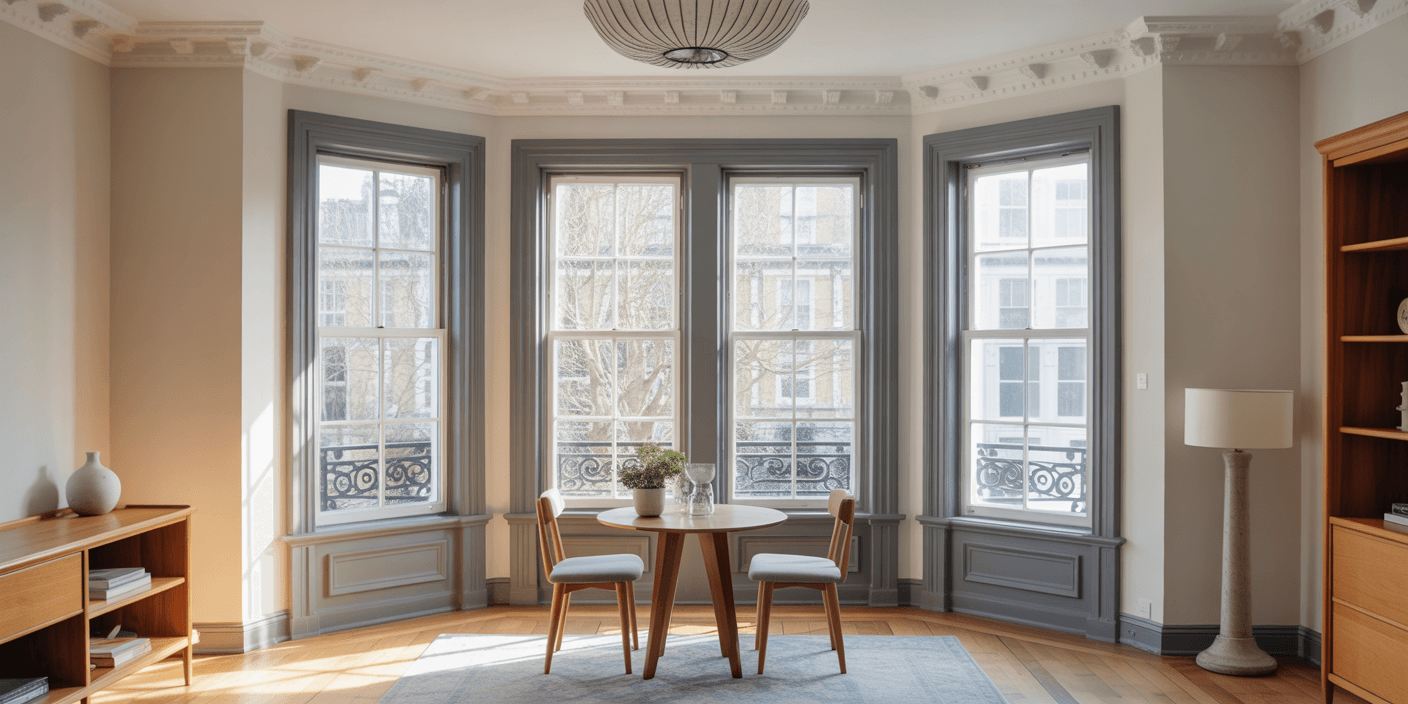Why Glazing Metrics Matter More Than You Think
British homes lose up to a fifth of their heat through the windows alone. The result is familiar: draughts in winter, stifling heat in summer, and energy bills that outpace the thermostat.
The causes lie not just in the panes of glass you see, but in the technical values you rarely hear about—U-values, R-values, and SHGC. To many, they sound like jargon. In reality, they are the silent regulators of comfort and cost.
Get them wrong, and you lock in years of wasted energy and discomfort. Get them right, and you secure a home that is warmer in January, cooler in July, and more economical all year round.
For sash windows, the stakes are even higher. They are expected to deliver modern performance while preserving architectural character. Meeting both demands requires precision, not guesswork.
This guide explains how these glazing metrics work, why they matter, and how they can be applied to sash windows with both scientific rigour and respect for design heritage.
U-Values Explained Simply
Think of your home as a container. The higher the quality of the lid, the less heat escapes. In windows, that lid is measured by the U-value.
A U-value is shorthand for thermal transmittance. The lower the number, the less heat sneaks out of your house. In practical terms:
- Old single-glazed sash windows: often around 5.0 W/m²K. They lose heat as quickly as an open vent.
- Modern double glazing: typically 1.4–1.6 W/m²K. A dramatic improvement, cutting heat loss by two-thirds.
- High-performance or Passivhaus glazing: below 1.0 W/m²K. The gold standard, where heat barely trickles through.
Here’s the truth most homeowners miss: every decimal point matters. A small shift in U-value translates into hundreds of pounds saved over the lifespan of your windows. And in larger properties—think detached houses or Georgian terraces—the savings multiply.
This isn’t just about energy bills. Lower U-values mean warmer rooms in winter, fewer draughts, and a home that feels consistently comfortable. It’s the invisible backbone of thermal performance.
But U-values don’t work in isolation. They must balance with other measures—like R-values and SHGC—to avoid the trap of focusing on one number while ignoring the bigger picture.
That’s why understanding U-values isn’t optional—it’s the first step in designing windows that are both beautiful and efficient.
R-Values and Their Inverse Role

If U-values tell you how much heat escapes, R-values tell you how much resistance your window puts up. Think of it as the same story, told in reverse.
An R-value is the inverse of a U-value. Mathematically, it’s as simple as R = 1 ÷ U. A high R-value means better insulation. A low R-value means the window barely resists heat flow.
So why bother with two measures of the same thing? Geography. In Britain and Europe, we talk in U-values. Cross the Atlantic, and you’ll hear R-values instead. For homeowners who research global standards—or developers comparing suppliers—the distinction matters.
Let’s translate:
- A U-value of 1.4 W/m²K (good double glazing in Britain) equals an R-value of 0.71.
- A U-value of 0.8 (triple glazing or Passivhaus level) equals an R-value of 1.25.
The numbers are different, but the principle is identical: the higher the R-value, the stronger the thermal barrier.
For the eco-renovator weighing options, or the architect managing specifications, R-values offer another lens on the same performance story. And in sash windows—where design heritage meets the demands of modern living—understanding both measures avoids confusion when suppliers speak different languages.
At the end of the day, U-values and R-values are two sides of the same coin. The trick isn’t learning both by heart. It’s working with a partner who can translate them into results you feel in your home, not just in a spreadsheet.
SHGC: The Forgotten Metric
Most people stop at U-values. They think only about heat escaping in winter. But what about the other half of the story—heat entering through your windows? That’s where the Solar Heat Gain Coefficient (SHGC) comes in.
The SHGC measures how much solar energy passes through the glass. It runs on a scale from 0 to 1. The closer to 1, the more heat and light pour in. The closer to 0, the more the glass blocks.
Here’s why it matters:
- Too high an SHGC: South-facing rooms overheat. Conservatories feel like greenhouses. You’re forced to draw blinds on sunny days—wasting the daylight you paid for.
- Too low an SHGC: You miss the free warmth of the sun in winter. Heating systems work harder, bills creep up.
The sweet spot depends on your home. A Victorian terrace in London with south-facing bays needs a different balance than a modern detached house with shaded elevations.
This is where many homeowners stumble. They optimise for U-values, but ignore SHGC—and end up trading one problem (heat loss) for another (summer overheating).
In sash windows, SHGC is particularly important. Large panes of glass with slim sightlines invite in generous light. That’s the beauty. But if the wrong glass is chosen, comfort suffers.
When these metrics are balanced, you get the best of both worlds: warm winters, cool summers, and light-filled rooms that feel like they were designed for you, not against you.
The Interplay: Comfort vs Compliance
A window isn’t judged by one metric. Comfort comes from the interplay of U-values, SHGC and R-values. Get one wrong, and the whole system falters.
The challenge for homeowners is that comfort rarely aligns neatly with regulations. Building Regulations set thresholds:
- Part L demands lower U-values to reduce energy use.
- Part F calls for ventilation to stop homes from suffocating.
- Part O now tackles overheating risks in new builds.
These rules are written for compliance, not for your lifestyle. They ensure you meet minimum standards, but they don’t guarantee comfort. That’s why so many new builds tick the regulatory boxes yet still feel stuffy in summer and draughty in winter.
The truth? Regulations are a floor, not a ceiling. A good sash window should exceed them—designed for real living, not just paperwork.
This is where Sash Windows London acts as a quiet hero. Instead of forcing you to choose between authenticity and efficiency, between beauty and compliance, they engineer balance. Their glazing choices aren’t made in isolation; they are calibrated. Low U-values where heat loss is the risk. Optimised SHGC where solar gain matters. R-values matched to the depth and material of the frame.
It’s a craft, but it’s also science. And it’s where most suppliers stumble—offering generic “A-rated” windows that pass regulations but don’t actually solve the homeowner’s problem.
Sash Windows London takes a different route: performance tailored to property, orientation, and lifestyle. A bespoke equilibrium of comfort and compliance.
The R-Value – The Unsung Partner

If U-values and SHGC steal the spotlight, the R-value is the quiet partner working backstage. Where U-value measures how easily heat passes through, R-value flips the equation: it measures how strongly a material resists heat transfer. A higher R-value means stronger insulation.
Think of it as the unseen insulation layer that allows the glazing to perform at its best. A superb pane of low-E glass can’t do its job if it’s mounted in a flimsy, poorly insulated frame. This is where so many “off-the-shelf” windows let homeowners down. The glass promises efficiency, but the frame leaks it away.
Traditional sash windows are especially vulnerable. Their slender profiles and moving parts leave little room for insulation. That’s why poorly restored sashes rattle in winter and sweat in summer.
Sash Windows London approaches this differently. By carefully selecting frame materials—whether solid timber with thermal breaks, or composite alu-clad designs—they raise the R-value of the entire system. Their craft ensures the resistance in the frame matches the efficiency of the glass. The result? A window that not only complies with Part L but feels consistently warm at the touch, even in January.
The R-value may not feature in glossy brochures, but it’s the metric that distinguishes a well-engineered window from a cosmetic replacement. Ignore it, and you’ll end up heating the street. Respect it, and your windows become part of your home’s thermal armour.
Bringing the Numbers to Life
It’s easy to get lost in the alphabet soup of U-values, SHGCs and R-values. But what do they actually mean for the way you live? Let’s bring the numbers into real homes.
Imagine a south-facing Victorian bay window. In summer, the sun streams through from dawn to dusk. A low U-value alone won’t save you—you need the right solar heat gain coefficient. Too high, and the room becomes a greenhouse. Too low, and the room looks dull, robbing it of its character. The trick is balancing enough SHGC to enjoy natural light while filtering out excessive heat.
Now take a north-facing bedroom in the same house. Here, solar gain is almost irrelevant. What matters is retaining warmth during long winter nights. That’s where a low U-value and a strong R-value frame keep the chill out.
Or consider a modern extension at the back of a London terrace. Floor-to-ceiling glazing brings drama and light, but without careful calibration, it risks failing Part O’s overheating criteria. With advanced glass coatings and thermally broken frames, you can meet compliance while still achieving the design’s architectural intent.
This is where Sash Windows London earns trust. They don’t sell windows in isolation. They design them in context—matching glass, frame, and orientation to the life lived behind it. Each decision is tuned to whether you’re sipping tea in the morning sun, working in a shaded study, or tucking children into bed on a cold January night.
Numbers become comfort. Compliance becomes invisible. The home becomes effortless to live in.
From Numbers to Action – The Next Step
U-values, SHGCs, R-values. They may sound abstract, but they shape how your home feels every single day. They dictate whether your sash windows are a source of pride or frustration, whether your heating bills stay flat or spiral, and whether your home quietly exceeds regulations—or just scrapes by.
The truth is simple: the wrong window is expensive twice. First, in the installation. Then, every year that follows.
This is where Sash Windows London stands apart. They don’t just install glass; they engineer living comfort. Every recommendation is tailored—frame, glazing, and compliance working as one system. They translate regulations into clarity, numbers into peace of mind, and craftsmanship into daily comfort.
If you own a period property in London, or you’re planning a modern extension that demands both aesthetics and performance, the next step is clear. Don’t let compliance be a box-ticking exercise. Don’t settle for generic “A-rated” promises.
Sash Windows London has spent decades mastering the balance between heritage beauty and high performance. Your home deserves more than minimum standards—it deserves windows that feel as good as they look.
→ Start your consultation today.
Let the experts at Sash Windows London tailor the right solution for your property, your lifestyle, and your peace of mind.







